The Legend of Zelda: Spirit Tracks Review
The Legend of Zelda: Spirit Tracks
Zelda at its finest and an unmissable handheld epic.
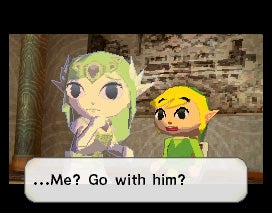
Verdict
Key Specifications
- Review Price: £27.47
Hands up. I confess. In retrospect, like a lot of people, I probably over-rated The Legend of Zelda: The Phantom Hourglass. It was so great to see a proper Zelda game running on a handheld system, and so easy to be bowled over by the game’s sublime use of the DS hardware, that I was prepared to gloss over some of the details that – in the end – dragged the game back from greatness. I might have turned a blind eye to the limitations of the games world, to the lack of excitement in its oceans, and toned down my darker thoughts on the hideous frustrations of The Ocean God’s Temple. Don’t get me wrong: I still think it’s a brilliant DS game. But classic Zelda? No. Not quite.
With Spirit Tracks, there’s really nothing to ignore, excuse or gloss over. It is classic Legend of Zelda, through and through. It feels like a fully-worked, whole-baked addition to the core Zelda canon, and it’s a sprawling, wondrous, fearsomely challenging adventure that will soak up hour after hour of your spare time. We’re not talking about a great handheld Zelda, but a great Zelda and a great game full-stop.
Like The Phantom Hourglass, Spirit Tracks takes its visual cues from the controversial GameCube Zelda, The Wind Waker, and once again the cel-shaded, heavily stylised visuals are a perfect match for the limited 3D capabilities of the DS. True, you’ll have to put up with some blocky characters and ugly low-res textures from time to time, but the character and creature design, the animation and the overall production values are so good that the overall effect works brilliantly.
Spirit Tracks also adopts and improves the Phantom Hourglass’ superb touchscreen control system, meaning you can run, fight and throw a boomerang around without ever having to reach for the D-Pad or face buttons. The combat controls seem to be a little faster and more responsive this time, and it actually leaves you wondering why more DS games – particularly RPGS and adventures – haven’t taken Nintendo’s lead and adopted a similar system. 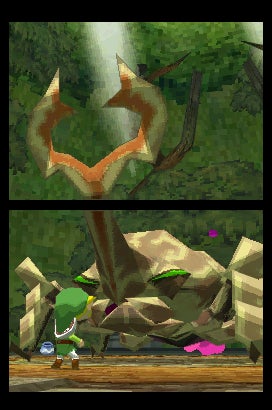
Unlike The Phantom Hourglass, Spirit Tracks is not a direct sequel. Instead, the new game picks up several thousand years later, with a new youthful Link in training to become a locomotive engineer, and a new Princess Zelda in need of a hero. Still, while the protagonists change, you can rely on some things staying pretty much the same. In fact, in terms of general plot and structure, Spirit Tracks is actually one of the more conservative Zeldas of recent years.
After the traditional scene-setting prologue we’re back to locating the next dungeon, completing a few tasks in order to open it, surviving a few floors of death-trap puzzles and deadly creatures, defeating a mini-boss, gaining some new weapon or implement, then using said weapon or implement to complete the dungeon and destroy its boss in a final, set-piece battle. Then repeat. If you’re one of those people that moans that every Zelda is really just the same game, then you’ll still find plenty to moan about here.
Luckily, there’s more, much more, to cheer about. For a start, the worst aspect of The Phantom Hourglass – the use of a repeated central dungeon which you have to work through under a draconian time limit – has gone. Spirit Tracks has a central dungeon – The Tower of the Spirits – but you’re not expected to repeat sections of it, and there’s no hourglass running out to spoil your chances either. I’m sure that all of us who grew to hate Ocean God’s Temple in the last DS Zelda will be very happy about this indeed.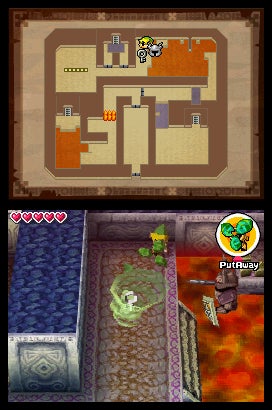
Better still, this Zelda has jettisoned The Phantom Hourglass’s paddle steamer for a much more enjoyable form of transport: the steam train. In fact, the whole premise of the game is that a monstrous evil has been trapped under the aforementioned tower, and that the tower’s magic relies on power routed through the spirit tracks of the title, which criss-cross the land. Over the years these have disappeared, and it’s up to you to restore them. In short, no train, no game.
On the one hand, all this locomotive malarkey cuts down on your freedom to roam around the game world as you wish, but on the other there’s no denying the fun of tootling around on the Spirit Tracks of the title, sounding the whistle as you pull into a station and changing direction at the junctions. And while the initial novelty of train travel should wear off pretty quickly, the game steadily trickles in new elements to keep things interesting. First comes a cannon, which you can use to blast hostile creatures, and before you know it you’re dealing with easily disgruntled passengers, warp gates and even freight. It’s the Zelda-loving trainspotter’s dream come true!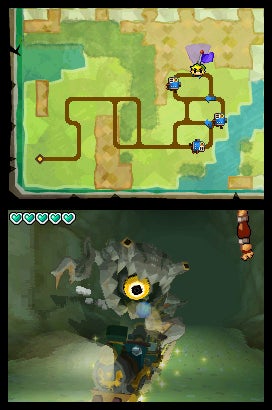
Yet the really good news is that, once you get into the minute by minute detail, there’s actually more new and interesting stuff going on here than you’d think. For a start, this is the first Zelda game where the title character actually has more than a walk on part. Here’s how it works. Early on in the game, the princess is attacked by demonic forces, and her soul separated from her body. Luckily, her spirit survives the experience and accompanies Link on his adventures.
Up to a point, Zelda works like Navi in Ocarina of Time, but when you run up against phantoms – the huge, animated suits of armour from The Phantom Hourglass – you’ll soon discover that she has another talent. Defeat a phantom (which is harder than it sounds) and Zelda can possess its armour, enabling her to distract or combat other phantoms or battle smaller creatures, defend you from missiles or flames, or carry you on a shield through lakes of molten lava.
Mostly, the Zelda-possessed phantoms will follow you around without your help. Tap the Call button on the touchscreen and she’ll do her best to reach you, and the AI is generally pretty credible. There are, however, times when you’ll need to take direct control, tapping an icon to transfer focus from Link to the phantom, then drawing a line on the screen for Zelda to follow.
Dragging the line to an enemy or object will get Zelda to fight or interact with it. It’s a great, intuitive system, and one the game uses for more and more ingenious puzzles and battles as time goes on. While this leads to some pretty frantic scribbling and tapping in later stages, the game takes enough time to build your skills. It adds a new dimension to Zelda, and one that’s a lot of fun.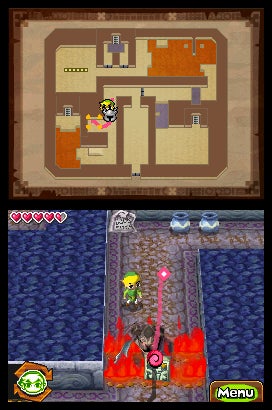
In the meantime we also get some other nice features that make effective use of the DS hardware. The touchscreen boomerang of The Phantom Hourglass is back – just draw on the screen and projectile will follow – and it’s joined by a cool whirlwind cannon which you fire by moving a line on the screen and blowing into the DS microphone. There’s more mic-blowing action with the Spirit Flute, which you use to play magical tunes in a distinctly Ocarina of Time style. I’ll leave you to discover the delights of the Snake Whip and Sand Wand, but you can be sure that cool gadgets are not short on supply.
Now, a truly great Zelda game really needs two things: a rich, interesting game world that you desperately want to explore and a set of ingenious, mind-bending dungeons that will challenge your wits and your nerve. Spirit Tracks has both. If you like Zelda because you like the side quests, the silly bonus collecting missions and the cast of weird, oddball characters, then Spirit Tracks won’t disappoint you. It’s full of nutters who want to engage you in peculiar and slightly pointless tasks. If you want a break from the main story, then there’s plenty of scope for rabbit capturing, stamp collecting and statue awakening adventures.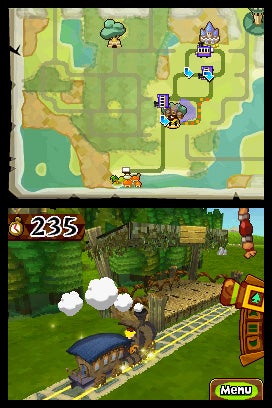
The quests in-between dungeons, meanwhile, feel more fleshed out and less like filler than they perhaps did in the previous Zelda title. The dungeons are simply in a different class altogether; the monsters are tougher, the puzzles more layered and more challenging. Where the dungeons in The Phantom Hourglass could be conquered without much difficulty, these will take you a bit more effort, imagination and persistence. If you can get through the game without at least a squint at an FAQ, then you’re a better man than I.
And that does bring me to my one major criticism of the game. For the most part, Spirit Tracks is tough but fair. I’m sure some players will find elements like the evil trains that hunt you down on the spirit tracks annoying, but with careful route planning and a little point-switching improvisation, you will get past them.
What’s less forgiveable is that there are times when the game doesn’t quite signpost what you need to do or a skill you need to have before you make your way halfway across a quite extensive game map to the next objective. In one case, I failed to pick up a visual cue, and as a result was left without a song I needed to proceed, resulting in a good hour of fruitless wandering around until I finally resorted to an FAQ for assistance. In hindsight, 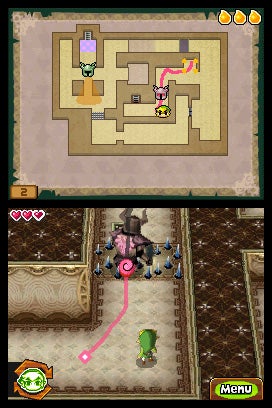
I was probably being a bit thick, but in the past the series has always been very good at drip-feeding you everything you need without openly shoving it in your face. Spirit Tracks still manages this pretty well, but when it does fail it can be annoying. That said, we’re not talking serious levels of annoyance, and the game as a whole is so damn wonderful that you’ve forgotten about it by the time you’re halfway through the next dungeon.
The close of this year has been great for handheld gaming. Much as I’ve enjoyed the console big hitters like Uncharted 2, Forza 3 and Assassin’s Creed 2, it’s been great to dust off the DS and wipe the cobwebs from the PSP and enjoy games as excellent as LittleBigPlanet, Professor Layton and Pandora’s Box and Jak and Daxter: The Lost Frontier.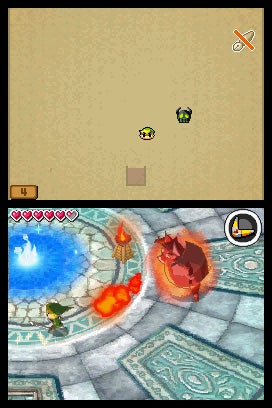
These aren’t games that have been cut-down into bite-sized portions for mobile consumption (I’m looking at you, Gran Turismo PSP), but big, meaty games that you can lay down on the sofa and lose yourself in for hours. Sure, you’re aware from time to time of the limitations of the hardware, but not in any way that seriously affects your experience of the game.
The same goes for Spirit Tracks and, really, it’s the best of the whole bunch. If you’re one of those people who finds the Zelda series too staid or too childish, then Spirit Tracks won’t change your mind, but are you absolutely sure it’s not you who’s missing out? Personally, I wouldn’t be without it.
Verdict
If The Phantom Hourglass was nearly classic Zelda in the palm of your hand, then Spirit Tracks is the real deal. An unmissable handheld epic.
Trusted Score
Features
| Genre | Action/Adventure |
| Player(s) | 1, 4 |

